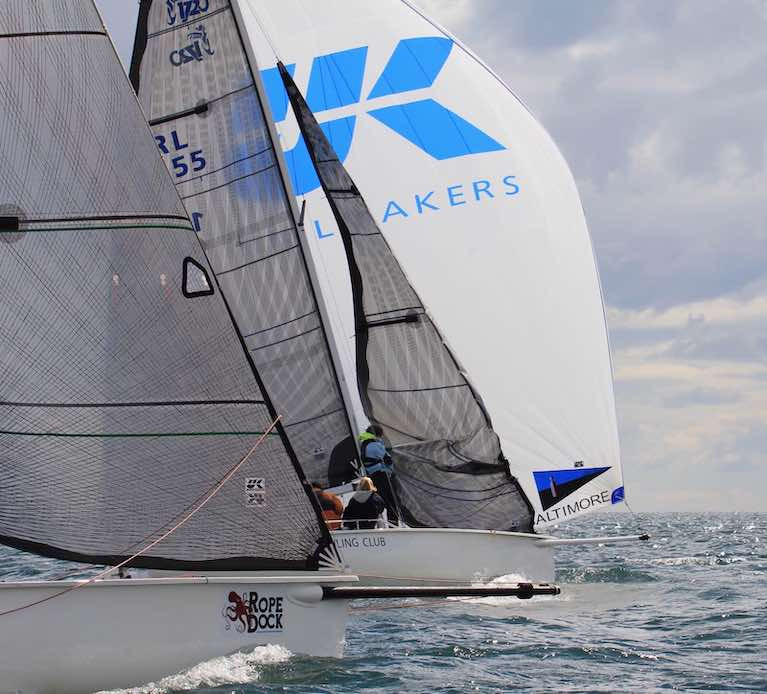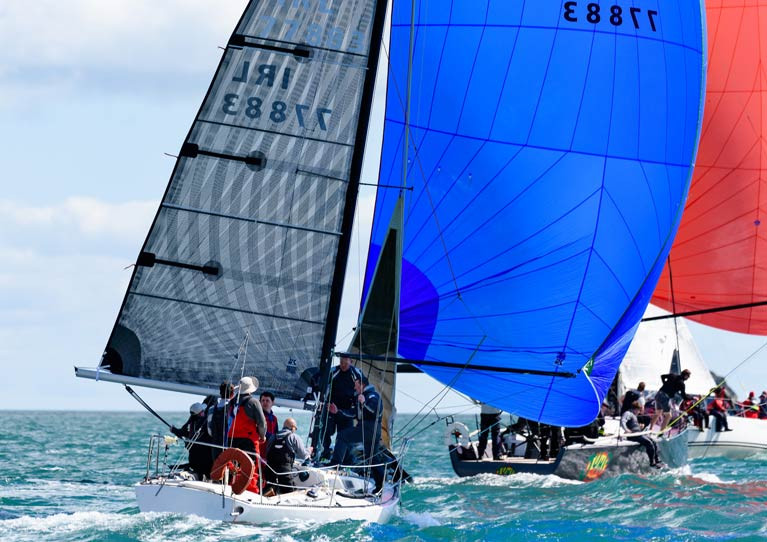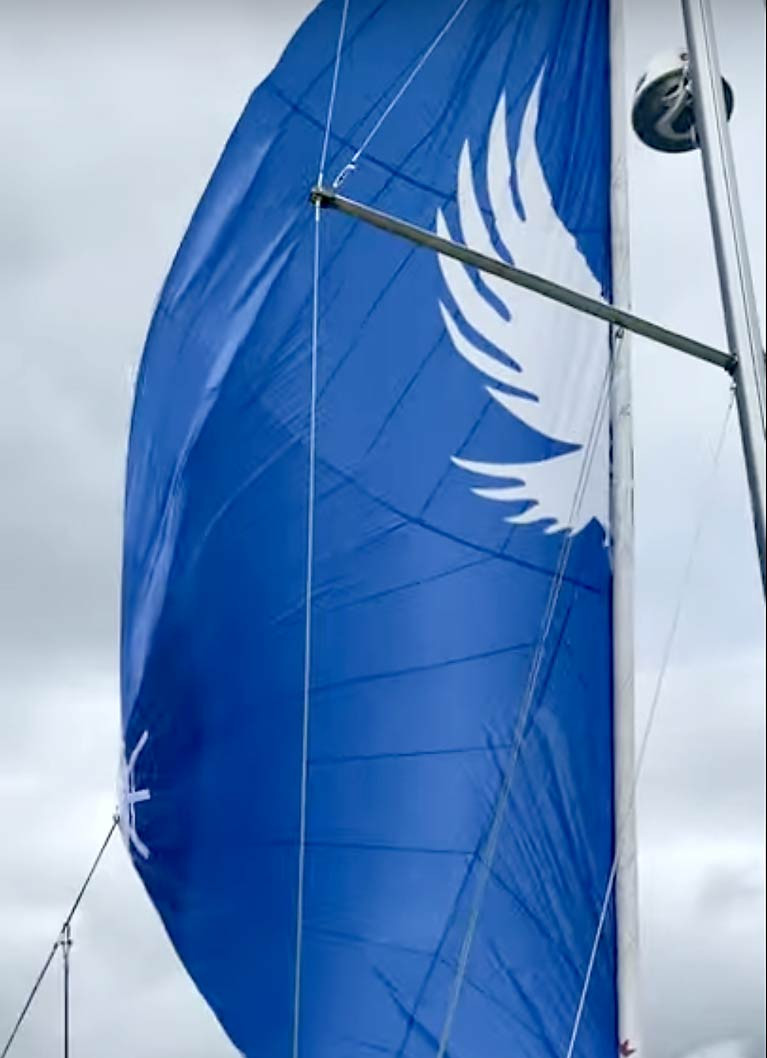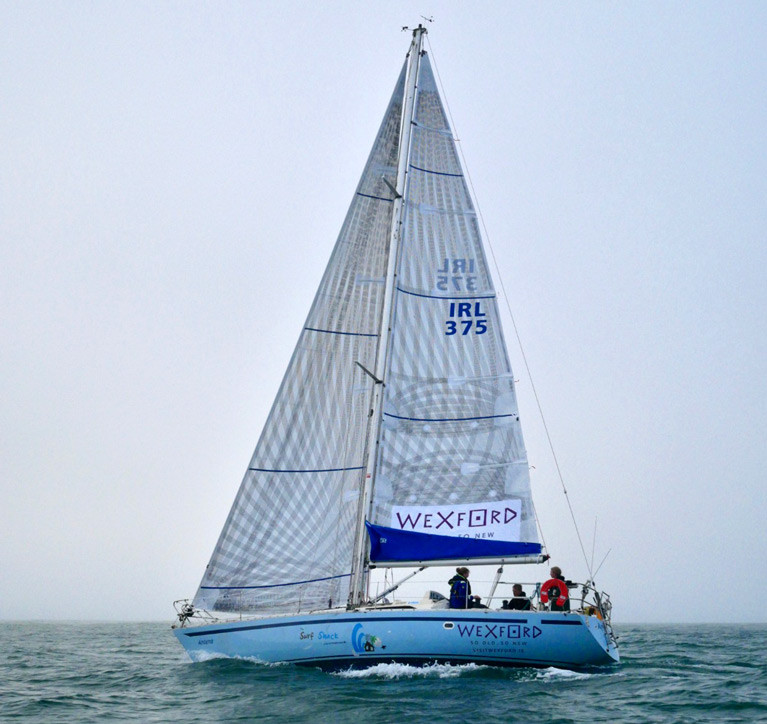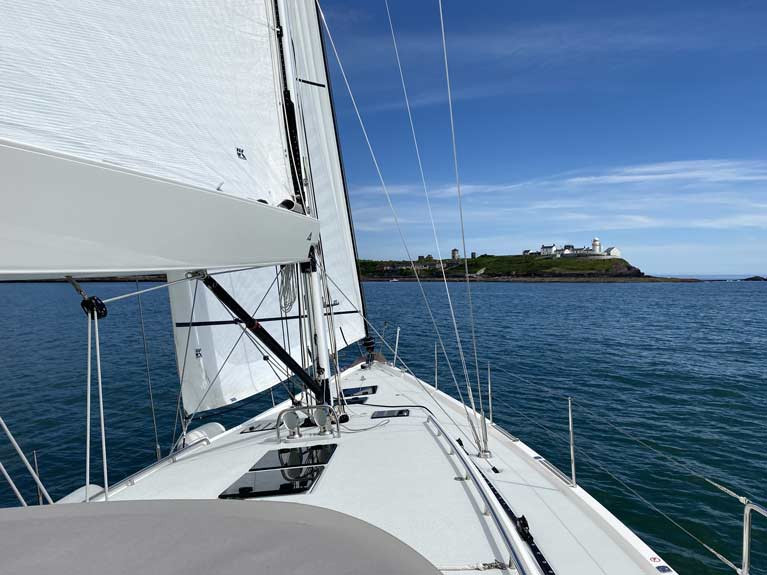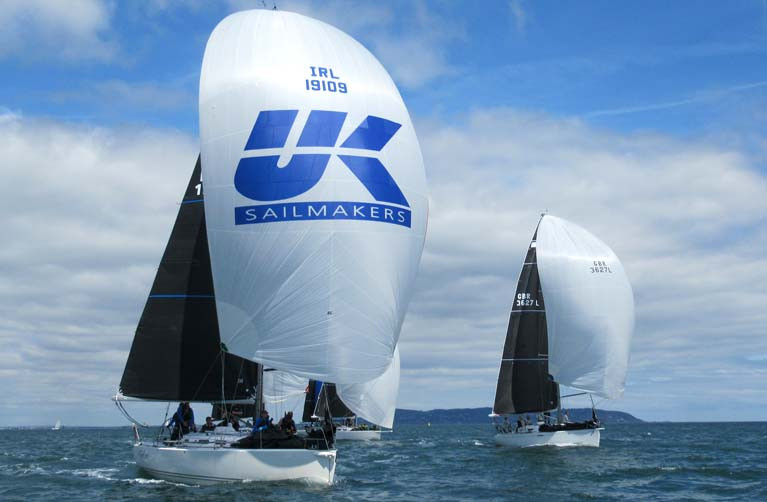Displaying items by tag: UK Sailmakers Ireland
Winter Sails Discount 2020 – UK Sailmakers Ireland
Next Thursday week (September 8th) is the last evening race in the 2020 Dublin Bay Sailing Club season writes Barry Hayes of UK Sailmakers Ireland.
As the summer season draws to a close, it is time to consider what we can do to improve your 2021 season.
Take advantage of the autumn sailing season to assess your sail wardrobe needs and where you can improve.
Bolster your sail wardrobe for maximum performance
New sails make a big difference to your boat's performance both on and off the race track. Getting the right sail for your boat is key to planning your new season on the right foot.
 (From left) "Outrajeous" Sovereign's Cup Champion – "Rockabill VI" ISORA Champion (partial inventory) – "Mermaid IV" Dun Laoghaire Week Coastal Champion (partial inventory
(From left) "Outrajeous" Sovereign's Cup Champion – "Rockabill VI" ISORA Champion (partial inventory) – "Mermaid IV" Dun Laoghaire Week Coastal Champion (partial inventory
And there is no better time to buy than during the autumn period with up to 15% off retail pricing. Make the most of your autumn sailing.
It's also a great time to take advantage of the new VAT rate of 21% on top of your winter discount.
Contact any of us for advice, guidance, and a quote today. See contact details below.
We've been working hard this weekend to keep the 1720 sportsboat boys in the game at the AIB Southern Championships at Royal Cork Yacht Club.
When you rip it, UK Sailmakers Ireland can fix it in time for the next race!
That has certainly been the case this weekend after a very breezy start to the championships on Friday leading to lots of sail repairs required at short notice.
See some examples of the overnight work at the loft below that included some tricky torn spinnaker luffs!
 This red 1720 Asymmetric had a small hole in the leech. We cut out the broken area and repaired it
This red 1720 Asymmetric had a small hole in the leech. We cut out the broken area and repaired it
 This white 1720 Asymmetric tore the luff at the spreader so we replaced the panel
This white 1720 Asymmetric tore the luff at the spreader so we replaced the panel
Cork Harbour sailors Mel and Kieran Collins from Crosshaven describe how they transformed Coracle VI, their vintage Olson 30, into an 'IRC weapon'
Prior to buying the boat, we did extensive research on which boat to buy and why. The Olson 30 designed by George Olson of Santa Cruz, CA, around 1978 was built around the same time as the Half Tonners; but the boat was a strict one-design class in the U.S. and was a predecessor of the sports boats that came 15 years later. For its day, the Olson 30 is a highly unusual boat in that it planes downwind in about 20 knots. To put it another way, it needs about two knots more wind to plane than a 20-year newer design like the 1720. Loads of useful background info on the Olsson can be found here
Going in, we wanted a boat that was both enjoyable to sail and competitive for club racing. It turned out better than we hoped. Working out whether it would be competitive in IRC rating, however, was the difficult thing.
A few Olsson 30s had raced IRC in the states, but IRC just really is not the dominant rating rule there. So, while we had an idea what the handicap would be with the 155% overlapping genoa, we did not know how competitive that would be on IRC here. The only thing we could do was use a spreadsheet to convert PHRF handicaps to IRC and compare boats that we know raced in Europe, too. The J/109 and J/24 were the most obvious contenders, but there were a few others. We also had access to quite a few good ORC handicap calculations and the Olson 30 compared favourably to boats we knew.
 Coracle VI under spinnaker Photo: Bob Bateman
Coracle VI under spinnaker Photo: Bob Bateman
After buying the boat, we started off trying out the 155% #1 genoa, the 130% #2 genoa, and 100% #3 headsail. The feeling was the 155% needed eight crew and really had the boat overpowered over 10 knots. It was also quite difficult to handle a bigger crew as the cockpit in the Olson is quite small. The Olson was designed as an offshore boat.
With that information, we contacted UK Sailmakers Ireland about a large new spinnaker so that we might be able to plane a bit earlier and an overlapping genoa, 140% genoa designed to fit the to the max area.
This proved a competitive setup for the Olson 30. We were unbeatable if we got over 20 knots of breeze in planning conditions with the genoa and larger kite.
In light conditions, we could keep up with, and race very closely with the Half Tonners, if not quite beat them; we could beat pretty much most other boats in these conditions in our class as well.
Getting the design of the sails and area right took a fair bit of thought and design. We were lucky enough to work with UK Sailmakers Ireland who were able to 3D model the sail design so we could see what we were getting before we ordered. As such, we knew we were going in the right direction.
 Ideal conditions for the Olson 30 in Cork Harbour
Ideal conditions for the Olson 30 in Cork Harbour
Breezes of 10-15 knots is about ideal condition against most boats except Half Tonners; we were fast downwind and get the most out of the 140% overlapping genoa upwind. Still, we only start to beat the Half Tonners over 12 knots. Unfortunately, at 13 knots the larger boats, like a J/109, would come into their own and we would struggle. Regardless, this left us in a good position in that if we got mixed conditions, we would be competitive.
There really was no weakness, but to be sure of a win we needed 20 knots plus, which is rare in our racing area. We were not happy to just leave it at that. We looked at a few other enhancements at his point: an asymmetric spinnaker and adding weight to the boat (as it is exceptionally light – 1,600 kg) Neither made any real difference to the IRC rating on trial certs.
In 2020, we decided to look to optimize the boat further. We focused on optimising the sail plan and the hull displacement, we looked at reducing the spinnaker area a little as we felt we didn't get the benefits in light air from the very large spinnaker unless we were reaching. Dead downwind it was hard to fly. While a real weapon in the 10-20 knots wind range, we felt the larger chute did not help much under 10 knots.
 A 100% non-overlapping headsail
A 100% non-overlapping headsail
The second thing we did was move to a 100% non-overlapping headsail. We worked with UK Sailmakers to design a headsail that would fit the foretriangle to the max plus a new, slightly smaller optimised S2 symmetrical spinnaker. The sails were designed in 3D, so it fit the rig perfectly with the max area. We worked out the headsail area from that and ran a trial cert.
By moving from a 140 % to a 100 % headsail and the smaller spinnaker, we received a 12-point drop in our rating.
Our feeling was that, in light air under 10 knots, we may still struggle with Half Tonners, but we should be still competitive against all other boats. We do not expect much difference from the smaller optimised spinnaker but would expect to see some drop-off upwind in the lighter air. A change of 12-points is a big gain rating wise, so we will have to see how it all works out.
 By moving from a 140 % to a 100 % headsail and the smaller spinnaker, we received a 12-point drop in our rating
By moving from a 140 % to a 100 % headsail and the smaller spinnaker, we received a 12-point drop in our rating
In 10-20 knots. we still should go quite well if a little slower than before, but the 12-point handicap difference should easily make up for this. It also allows us to sail with one or two fewer crew; the boat is generally pretty cramped anyway.
We will now rate close to Half Tonners so should still be competitive against them and, as the wind goes up to 10 to 20 knots, we should be much more competitive against the big boats like J/109 also.
Really, the big risk is in sub 10 knots but over 10 we believe it will be a net gain. Onboard Coracle VI in light airs
Onboard Coracle VI in light airs
Barry Hayes of UK Sailmakers Ireland has been showing off a new 'Code D' gennaker that's been designed for simple and easy use.
The Cork Harbour sailmakers say the cruising sail furls easily every time as he demonstrates in the vid below.
Hayes also says the new sail design can also be hoisted before leaving the dock. And, as it’s on a ratchet lock, it can be opened whenever is required.
The Code D is top-down furling sail so, says Hayes, 'it’s a perfect furl every time'.
Now that’s a wrap!
UK Sailmakers Ireland: Headsail Trim & Vertical Camber
In this article, Barry Hayes (UK Sailmakers Ireland) and Pat Considine (UK Sailmakers Chicago) explain headsail vertical camber and why it’s so important to boat speed and performance of the boat. In reality, understanding headsail vertical camber is the modern headsail trimmer’s main tool to getting optimum speed and power out of the sail.
Headsail horizontal camber is always spoken about regarding how the sail needs to develop the right shape, but vertical camber is also critical to the performance of the sail.
UK Sailmakers’ sail designers use vertical camber tools in their design programme to optimise a sail’s horizontal camber. The superior shape-holding characteristics of today’s moulded sails require proper setting of the car, halyard, and inhauler to get the horizontal and vertical camber correct.
 The red line indicates the sail’s vertical camber
The red line indicates the sail’s vertical camber
In the photo above, the red line indicates the sail’s vertical camber. The trimmer’s goal is to get the vertical camber line smooth and straight (as a plane’s wing), while keeping the twist in the leech of the headsail and getting the top of the headsail to open up and match the main sail slot (green line).
"you want to visualise a straight line down the back of the sail to the deck"
Looking at the back side of the headsail on the horizon will help you see the vertical camber and see how deep the sail is. When you’re looking for max power for the pressure you’re in, you want to visualise a straight line down the back of the sail to the deck.
 Setting-up a headsail to achieve correct vertical and horizontal camber is the key to power-generating headsail trim
Setting-up a headsail to achieve correct vertical and horizontal camber is the key to power-generating headsail trim
Setting-up a headsail to achieve correct vertical and horizontal camber is the key to power-generating headsail trim. There is nothing wrong by having the foot full in the headsail in light air, it’s like having the flaps down on a plane's wing when taking off to generate lift and power. In a headsail, a full foot provides power and pushes the bow down in light airs helping to balance the boat. It’s only when the boat reaches hull speed does this effect start to change whereby you need to flatten the horizontal camber in the sail, taking more foot round out of the headsail, and flattening the overall shape of the sail. To achieve this shape, you’ll probably want a tighter halyard, tighter sheet, and an eased inhauler. This is normally about 8 – 10 knots depending on your hull shape and stability.
 Sail twist
Sail twist
In the photo above, you can see the sail is twisting open, much like the ailerons on a plane’s wing, allowing the air flow to accelerate into the slot. This is the perfect amount of twist-to-vertical camber relationship in the sail. Having too little twist in the head will choke the slot and not allow the air flow to accelerate. To build boat speed, open the slot a little more as this will increase the air flow. When you’re up to speed, reduce the twist again so you’re making the most efficient use of the slot. Actively opening and closing the slot as speed and wind pressure vary, while minding vertical and horizontal camber, will allow you to get the maximum power out of your headsail.
 Excellent vertical camber on the Beneteau 50 Mermaid
Excellent vertical camber on the Beneteau 50 Mermaid
As you can see in the above photo, the First 50 MERMAID has excellent vertical camber. The headsail is almost touching the lifelines in 8 knots of wind. The leech is nicely twisted open which creates max power and aerodynamic performance.
As you get up past hull speed in heavier airs, you need to shift your focus with your headsail trim. Creating the least amount of drag possible and with the most efficient drive and leeway.
As you can see in the photo of a J 3 headsail below, the foot still has shape to match the vertical camber. The sail is not over inhauled so the boat is balanced and easy to steer upwind. Having the foot too flat and not match the vertical camber in the sail will not give the helm enough power to push the boat through waves and also increases the heeling effect. Remember, you need some power in the foot of the headsail to balance the vertical airflow in the headsail. If the sail is too flat in the foot, the airflow will separate too early creating a vacuum and slowing the boat down.
 The foot of the J3 headsail still has shape to match the vertical camber. The sail is not over inhauled so the boat is balanced and easy to steer upwind
The foot of the J3 headsail still has shape to match the vertical camber. The sail is not over inhauled so the boat is balanced and easy to steer upwind
Pat Considine, UK Sailmakers’ lead sail designer, added, “From an aerodynamic point-of-view, your objective is to have the foot of the headsail full in light airs and having the top of the leech twist open nicely (see photo below). This allows the headsail to deliver the most power without causing too much drag. You also can see in the photo how the air flow exits the top of the slot and flows quickly around the mainsail. At the same time, the lower portion of the sail’s air flow is moving at half the speed, generating power with smooth vertical camber in the headsail.”
 Having too little foot round in the headsail is sub-optimal because it reduces the overall vertical camber in the headsail
Having too little foot round in the headsail is sub-optimal because it reduces the overall vertical camber in the headsail
Having too little foot round in the headsail is sub-optimal because it reduces the overall vertical camber in the headsail and reduces the power generated by the airflow moving over the headsail. Conversely, in 12 knots, having too much foot found not enough leech twist will give you lift but at the expense of speed.
The ratio of vertical camber to leech twist is critical. Having a straight line down to the deck is a really good visual key to help you get the headsail trim right. While watching the twist in the top of the leech.
To learn more about both vertical and horizontal camber in a headsail, contact UK Sailmakers below.
How a Slow Cruising Boat Was Turned Into an IRC Racer
Keith Miller from Wexford transformed his Yamaha 36 from a slow cruising boat into a well-balanced and finely tuned IRC racer
Keith’s Yamaha 36 was doing a race to the Fastnet and back when his backstay parted bending the mast beyond repair. Considering this challenge as an opportunity, and working in partnership with www.visitwexford.ie he had a look into improving his Yamaha 36 by creating a better mast and rig set-up. Having read a lot of articles on Afloat about boat “balance” and what can be done to improve a boat’s performance, Keith contacted UK Sailmakers Ireland to see what improvements could be made to his boat.
Getting the Balance & Boat Speed
Keith and UK Sailmakers’ Barry Hayes then reviewed what his previous rig set-up had been and what Keith was willing to do to improve the boat. Given we had to find a mast that would suit what Keith goals were, we got in contact with New Zealand yacht designer Kevin Dibley of Dibley Marine to help us work out the best mast and IRC optimisation design considering the stability and lead (balance) of the boat.
Keith found a second-hand mast form an Oyster 395 which fitted the job perfectly. We then set about analysing the performance and rating that we could get out of the boat with that mast. Working closely with Kevin and crunching a lot of data we came up with a few options.
 Testing the reaching set up
Testing the reaching set up
Some of the options were: A) a fractional with an overlapping headsail with a smaller main, B) a masthead max non-overlapping headsail with an IRC main, and C) non-overlapping headsail with an oversized main. After scratching our heads and reviewing the data multiple times, we agreed the best plan for giving Keith optimal stability and performance was option B.
Working from there, we did detailed measurements of the boat and rig. Then we built a 3D module of the boat so we could see the aerodynamic drag calculations allowing us to develop the most efficient, aerodynamic sails package possible. All the time we kept in mind the objective of maintaining the stability and lead (balance)in the boat.
 Sail design set up and 3D modelling
Sail design set up and 3D modelling
Keith was focussed on offshore and IRC racing, so we went with X-Drive® Endure sails for offshore performance and reliability. The sails would also have taffeta and enough structural loading for durability with two reefs in his IRC roached main. The headsail was design to be furling with a horizontal battens and an IRC roach. The sail design modelling we did showed that this combination would result in the best durability and performance offshore.
As Covid-19 lifted, and Keith was able to get out sailing, he was itching to see how his plan had come together and see the performance first hand.
 The optimised Yamaha 36 sailing off Wexford
The optimised Yamaha 36 sailing off Wexford
Keith updated by email:
Just a quick word to say I was out on Andante at the weekend for the first time with the new rig and sails. We were out in around 10 kts of breeze Saturday and Sunday.
I believe the boat behaved beautifully and was very well balanced. On a reach with the new assym, she was very easy to steer; even when the helm was distracted and went too far upwind, she responded easily to the wheel to get back in control.
Going upwind we had the jib sheet on an inhauler at an angle I didn't think possible. We could steer with slight adjustments to the mainsheet and only about 2 degrees of rudder. I am absolutely delighted and can't wait to be up against some competition. I think we have given this old bus a new lease of life.
I only paid Kevin and UK Sailmakers Ireland €500 for this analysation work to give a new lease of life in this Yamaha 36. She is a totally different boat with excellent performance and stability. I am looking forward to getting out racing.
 Yamaha 36 Ireland Rig and Sail
Yamaha 36 Ireland Rig and Sail
The Backstay: How Much Is Too Much?
Barry Hayes from UK Sailmakers Ireland gives his top tips on the backstay and using it to get the most out of your boat
Now that we are back open making and repairing sail, getting back into sailing will be foremost on everyone’s mind.
Proper application of the various controls on your boat is critical if you’re looking to get the best performance out of your boat whether sailing doublehanded or fully crewed. The backstay is one of the most important controls on a boat and can be the go-to control to quickly and easily shift from power-on or power-off modes.
Here’s what to do:
UK Sailmakers Ireland Top Backstay Tips
1. Make sure your mast is in column side-to-side in base settings. Next, having the right amount of luff curve/mast prebend is critical for properly setting-up your mainsail. To check this base setting on the dock, fully tighten your backstay and see how flat your mainsail gets. You’re looking for a flat main sail that still has power (camber) as seen in the photo below (A). You can then use the backstay as needed to bend the mast and depower the boat or straighten the mast to power up. When checking at the dock, the mast should not be over bending. Consider this your base setting with max mast bend in 8-10 kts. To add a little more camber in the main sail, tighten your diagonal (lower) shrouds and D’s. Remember, a single turn on the D’s does a lot, so go easy.
 Photo A: A flat main sail that still has power (camber) Photo: Barry Hayes
Photo A: A flat main sail that still has power (camber) Photo: Barry Hayes
2. Your boat should be fully powered up and at hull speed using your base settings in 8-12 kts. At any higher wind range, your backstay is the tool that will help you control heel and power. In this photo 'B' below, see how the leech twists open with the backstay applied. Also notice how the tip of the mast starts to sag to leeward. This happens when the middle of the mast pushes forward letting the tip fall off and there isn’t enough leech tension on the mainsail leech to pull the mast back into column. This is a common issue that diminishes performance
 Photo B - Leech twists open with the backstay applied Photo: Barry Hayes
Photo B - Leech twists open with the backstay applied Photo: Barry Hayes
3. In winds from 12 to 18, working your traveller up and down the track and putting the backstay on hard. This should give you the correct rig tune for this wind range. Be careful not to over bend the mast as it will make the mainsail too flat. The boat should be fast, pointing, with a straight forestay. You can put marks on the spreaders to see how much forestay sag you have relative to the mast bend. These marks should be viewable from the mainsheet trimmer’s seat.
4. Use the backstay to help you “shift gears” in the 12 -18 wind range, tightening it to power off and easing it to power up the mainsail. If you need to balance the boat, adjust the backstay first, the traveller second, and the mainsheet third. The reason the mainsheet is the last adjustment is that you need a tight main leech to help balance the boat and keep it pointing.
 Photo C - 12-18 kts of wind. Hiking hard, traveller down, backstay on hard and pointing well
Photo C - 12-18 kts of wind. Hiking hard, traveller down, backstay on hard and pointing well
5. Over 18 kts, its backstay on hard and leave it. To control the balance of the boat in heavier winds, you can control the amount of mainsail twist with the mainsheet and traveller. You will know you have enough backstay tension when there is almost zero forestay sag. This is critical to get the boat pointing while also maintaining power. Only ease the backstay going downwind.
6. Over 20 - 30 kts., the backstay is full-on all the time regardless of whether you’re reefed of not...upwind and down. It’s of little use easing it as it only takes time to get it back on at mark roundings. Keeping it on also stops your mast from pumping on a reach and down wind.
7. Below 8 kts. the backstay is hardly used. Only use the backstay to control forestay sag. Reduce the amount of luff curve as the boat speeds up and gets to hull speed. It’s like changing from 3rd to 4th gear in the car; adding backstay controls the sail shape and resultant speed. In this photo below, with the boat in less than 8 kts., you can see the first 50 of is fully powered up and has sufficient backstay to control the forestay sag.
 First 50 Mermaid using her Uni Titanium sails to win DL Regatta Photo: Barry Hayes
First 50 Mermaid using her Uni Titanium sails to win DL Regatta Photo: Barry Hayes
Knowing when to use the backstay controlling boat speed, heel angle and main sail shape takes experience; but these simple tips will keep your boat up to speed with the perfect sail shape and pointing angle.
Claire Morgan is Sailor of the Month for April
When the story of the Covid-19 pandemic in Ireland finally comes to be written, there’ll be many individuals - both voluntary and professional - who will be recognised as having contributed way beyond the call of duty in helping to fight the scourge. In choosing Claire Morgan of UK Sailmakers of Crosshaven, who worked night and day to change and operate the company’s production line to meet the unprecedented demand for PPE gowns, we are honouring one in order to honour the many to whom we all owe our heartfelt thanks.
Symmetric Versus Asymmetric Spinnaker in IRC: What’s Best & Why?
Barry Hayes of UK Sailmakers Ireland goes through the different options for racing boats going 'Symmetrical' or 'Asymmetrical' with their spinnakers. What’s best and why?
In the past 15 years, spinnaker options have increased considerably. Prior to that, it was fairly straightforward. You bought a light air symmetric spinnaker, a heavy air version of the same, and maybe a reaching spinnaker. In recent years, however, asymmetric spinnakers have become a lot more efficient and some yacht builders, particularly J Boats, feature them almost exclusively on their models.
The following is an analysis of which option is better for racing inshore/offshore.
First the pros and cons of each option:
Asymmetric Spinnakers
Pros
- Easier trimmed and handled
- IRC rating allows larger asymmetric spinnakers for the same rating, relative to symmetric spinnakers
- Very efficient when reaching as the shape allows better exhaust of the air across the leeward side of the mainsail.
- Code zero models (very flat asymmetrics for close reaching) is a must for offshore boats
Cons
- Needs a sprit or prodder to set them properly away from the bow.
- They don’t run as deep and efficiently as symmetric spinnakers.
- In heavy air, they sometimes can wrap around the forestay when gybing
- Time is always lost gybing, compared to boats with poles
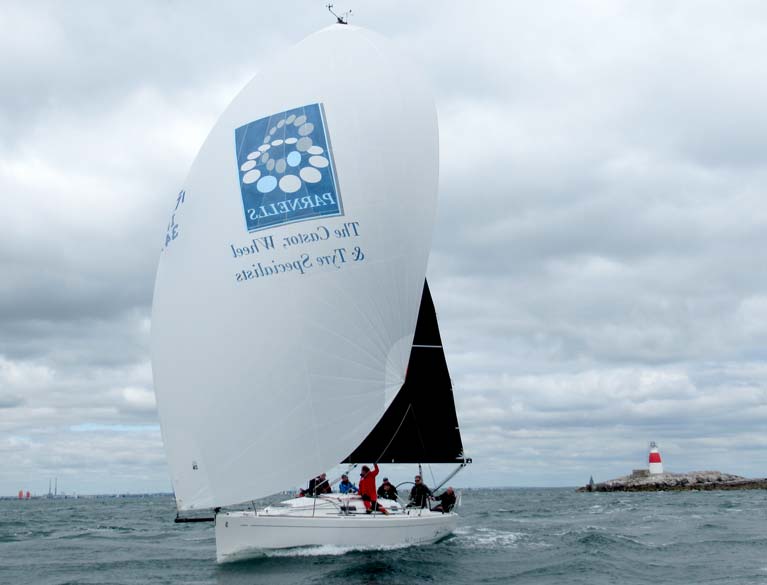 First 34.7 Black Velvet
First 34.7 Black Velvet
Symmetric Spinnakers
Pros
- Once above 12 knots, they are very efficient running with pole pulled back.
- Tactically, they offer an experienced crew greater options downwind.
- Very little time lost while gybing.
Cons
- Expensive on IRC rating – On a J/109, converting to a symmetric costs about 7 points if you want the same sized spinnaker
- Not as efficient when reaching due to shape
- More difficult to hoist and trim properly
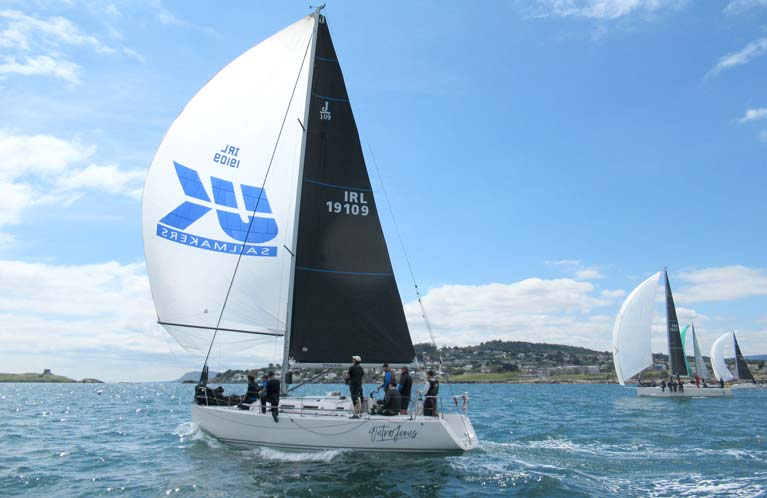 The J109 Outrageous
The J109 Outrageous
At UK Sailmakers Ireland, we had a J/109 client that opted to go for symmetric spinnakers on a boat that is designed for A-sails. Before we went down this route, we did extensive testing and trial certs to see what the benefits would be. We found that there is no perfect answer. If you were able to have two IRC certificates (one symmetric, one asymmetric), and be able to select which one, each race, then you would have both set-ups.
However, IRC does not allow this, and most regattas insist you don’t change your cert in the last 10 days before a regatta, as long-range weather forecast details may play a part in your decision.
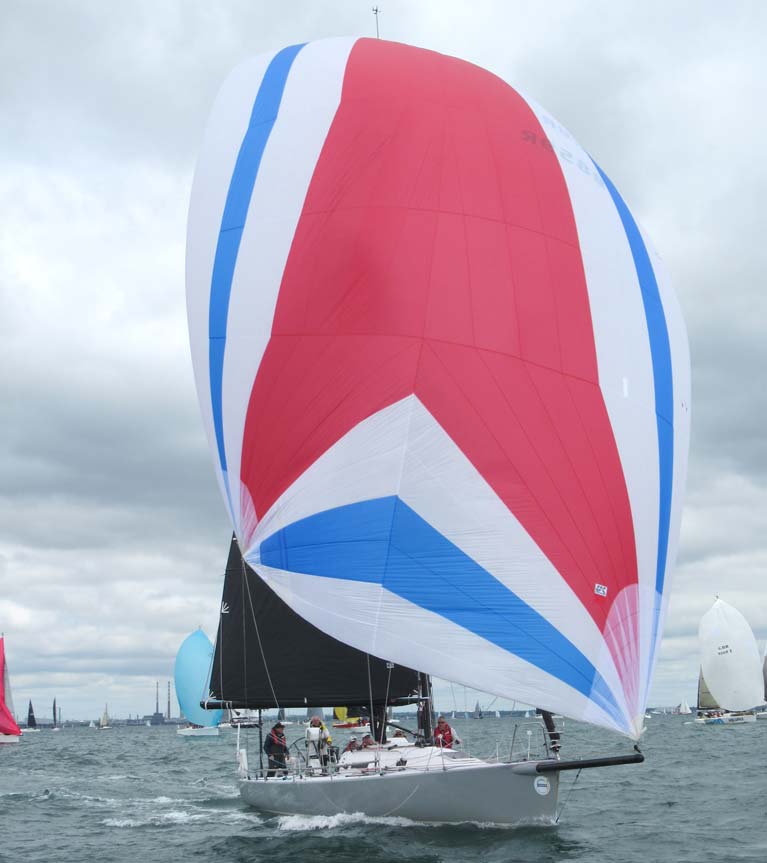 Andrew Hall's Jackknife
Andrew Hall's Jackknife
A-sails are generally more efficient on normal cruisers in less than 12 knots than symmetric spinnakers. Why?
Up to 12 knots, most symmetric boats struggle to get their spinnaker poles back far enough, as the spinnaker will collapse. So, an A2 asymmetric boat will likely be able to run as deep as an S2 symmetric boat, but the A2 asymmetric usually will have a larger spinnaker area and a lower rating. IRC, it appears, penalises a boat with a pole by about seven points (on a J/109), for the ability to be able to pull the pole back and go deep.
In light airs, if you can’t get the pole back, then you are at a disadvantage. Add to that, an asymmetric sail is more efficient going at higher angles compared to boats with symmetric spinnakers.
Symmetric spinnakers are more efficient running in more than 14 knots. Why?
Once a symmetric boat can get its pole fully back, it can normally nearly run square, or maybe 10 degrees off square. A similar designed boat with an asymmetric spinnaker will likely go the same speed but be 10 degrees or higher. When the two boats get to the bottom mark, the symmetric boat has likely pulled out 30 to 60 seconds. Add to this, the symmetric boat can throw in gybes easily to stay in wind or get away from other boats' wind shadows, and the gain becomes even larger. If the wind gets up to 20 knots or more running, the symmetric boats have an even bigger advantage.
 Paul O'Higgins' JPK 10.80 Rockabill VI
Paul O'Higgins' JPK 10.80 Rockabill VI
Asymmetric boats are generally more efficient offshore and on Coastal racing
This is because the two scenarios above relate to running square downwind, as you would have in Windward Leeward racing. On offshore and coastal races, often there is a lot of reaching and broad reaching. The A sail boats then have their rating advantage, and the efficiency of the A sail when reaching.
What are the crewing considerations?
Trimming a symmetric spinnaker is considerably more difficult to do well, than trimming an Asymmetric spinnaker. A symmetric spinnaker needs the sheet adjusted constantly, the guy adjusting the angle of the pole is constantly being adjusted, as is the pole height and the spinnaker tweaker.
On an Asymmetric sail, it is generally just the A sail sheet that is adjusted. You may move the tackline up and down, but not that much. As a result, to get the best out of a symmetrical spinnaker, more good crew are needed to trim it well.
What about boats having both sail setups?
Any boat opting for a symmetric setup should also be planning to take some Asymmetric spinnakers as well. To do this efficiently, it needs a small sprit or prodder, to use with the A-sail for reaching conditions. The IRC rule allows a prodder (or sprit) on a symmetrically configured boat, as long as the prodder does not extend out further than the pole does.
However, the A sail size (SPA) on these A sails cannot be any bigger than the largest symmetric spinnaker. So in the case of our J109 which went Symmetric, we opted for a 102 sq. metre Symmetric spinnaker, which is six sq metres smaller than the Class A sail size. This saved two points off the rating, so the seven-point hit for the pole was lessened to five points overall. The new A sails added, to cover her reaching requirements were a code 0 for light air reaching and an AO, for light air running. The AO can be used off the prodder, or can also be transferred to a lowered pole, with the pole being pulled back to allow further depth.
 In these photos, you can see the Warship 36 using both the pole (above) and Asym set up (below) with her UK Sails A0 and S2 spinnaker
In these photos, you can see the Warship 36 using both the pole (above) and Asym set up (below) with her UK Sails A0 and S2 spinnaker
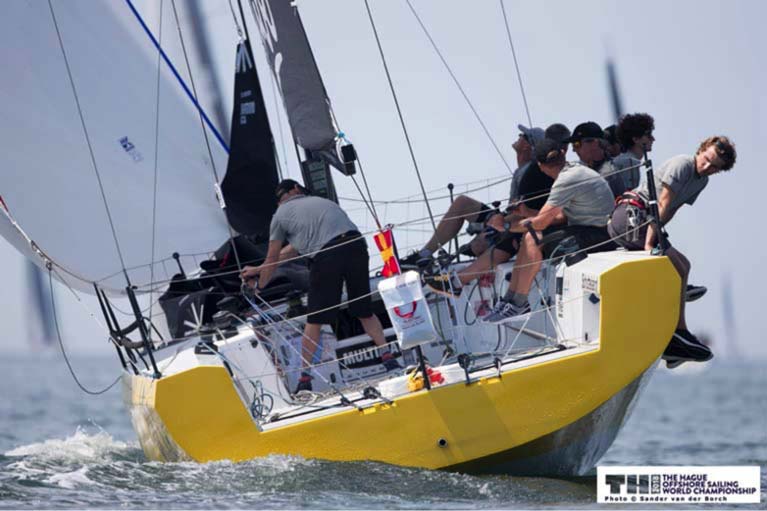
Cost Considerations
For an existing Symmetrical boat, changing to No pole and just using A sails would require,
- A sprit
- New Spinnaker specific A sail sheets
- New Asymmetrical spinnakers
- A tack line to attach the A sail to the Sprit
For an existing A sailboat, to go to symmetrical configuration requires,
- A pole
- A track on the mast
- additional Blocks etc. to cover sheets and guys and pole downhaul
- Symmetrical spinnakers and perhaps some A sails as well.
For someone ordering a new boat—it is best to try and incorporate both options from day one, even if only opting for one setup.
So, which option to go for?
As I said in my opening paragraph, there is no perfect choice, but here is a quick plan:
- For Light planing boats - Go A sail, as you will always be going higher angles
- For short-handed - A sail is a lot easier for Handling
- For Offshore/Coastal - A sail will likely be best, as more reaching than running
- For Inshore, in lighter air areas, go A-sail
- For Inshore in stronger wind areas - go Symmetric
- For Inshore in mixed conditions - Either works, but Symmetric with a good crew might just have the edge if you also have some good A sail options as well.
'We're Sewing as Fast as We Can': UK Sailmakers Delivers Gowns to Care Homes & GP Surgeries
Barry Hayes of UK Sailmakers Ireland reports that gowns (pictured above) made at his Crosshaven sail loft are destined for care homes and GP surgeries across the country in the fight against COVID-19.
'Our not-for-Profit makeshift gown making endeavour has also just secured a contract with the HSE to supply our healthcare heroes', he said on social media.
'We‘re sewing as fast as we can to keep these frontline services supplied!' Hayes adds.
As Afloat reported previously, the Cork Harbour sailmaker joined the fight against Covid-19 and are deploying their resources to help make Personal Protective Equipment (PPE) for local healthcare workers at the front line in the fight against this disease. 'Primarily, we are doing this to help fill the gaping hole between demand and supply of PPEs for healthcare workers', Hayes said.




























